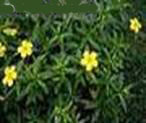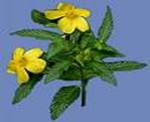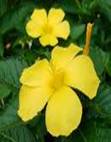| Kingdom | Plantae |
| Division | Magnoliophyta |
| Class | Magnoliopsida |
| Order | Malpighiales |
| Family | Turneraceae |
| Genus | Turnera |
| Species | T. aphrodisiaca |
| Binomial name | Turnera aphrodisiaca |
Other Common Names:
The other common names for the shrub damiana are Mexican damiana, Mexican holly, herba de la pastora and old womans broom.
History
Damiana is one of the most popular and safest herbs to restore natural sexual capacities and functions and has been used as an aphrodisiac, going back to ancient Mayan times. From 1888 to 1947 damiana leaf and damiana elixirs were listed in the National Formulary in the United States.


Description


Range
Damiana is a native of Mexico and grows on the brushy hillsides along the Rio Grande in South Texas, into West Texas, Southern California, the West Indies and South America.
Habitat
The ideal habitat preferred by the herb is a hot and humid climate. The herb flowers in the summer, when the harvesting of the leaves is carried out. It is generally seen growing in woodland, sunny edge and by walls.
Cultivation
Damiana may be planted outdoors in the South and West, or in the greenhouse in the North. It thrives in any good soil if given a sunny location. It should be watered freely from spring to fall, and sparingly in winter. In the greenhouse the temperature should stand around 55 degrees Fahrenheit at night. Damiana is propagated by seeds and cuttings. The leaves and tops are harvested while the plant is in flower in summer. As some of the active principle is volatile, the tops are preferably dried in the shade, without the application of heat. Seed are sown in spring in a greenhouse. Prick out the seedlings into individual pots once they are large enough to handle and grow them on in the greenhouse for at least their first winter. Plant them out into their permanent positions in early summer and give some protection from winter cold for at least their first winter outdoors. Division takes place in spring or autumn. It is possible that, whilst the plant will be cut back to the ground by cold weather, the rootstock is hardier and will re-sprout in the spring. It will certainly be worthwhile trying the plant outdoors and giving the roots thick protective mulch in the autumn.
Flowering Season
The stems are upright with small yellow flowers that produce sweet smelling fruit and are in bloom between early to late summer.
Pests and Diseases
Rarely it is said to be disturbed by aphids and powdery mildew. Other damaging insects include flatheaded borers like Chrysobothris azurea and Agrilus cephalicus.
Parts Used
The leaves of damiana are the most commonly used parts of the plant for its medicinal and commercial applications.
Medicinal Applications



• Damiana is a tonic and restorative for the nervous system, and has always been considered an aphrodisiac. Its tonic action is partly due to the constituent, thymol, which has an antiseptic and tonic action.
• It has been used for such conditions as depression, anxiety, sexual inadequacy, debilitation, bed-wetting, menstrual irregularities, gastric ulcers, and constipation.
• Helps balance female hormones and alleviate menopause symptoms.
• Other medical applications include being used to treat asthma, bronchitis, neurosis, and gastrointestinal problems such as dysentery. It can also relieve or reduce headaches.
• The damiana possesses both a diuretic and urinary antiseptic action, it is very effective in the treatment of urinary infections, including cases of cystitis and urethritis affecting patients.
• Traditionally the damiana has been linked to disorders affecting men, largely due to its strong testosterogenic quality, hence, the herb has always been principally considered as being useful for men. It is known to be helpful in the treatment of conditions such as premature ejaculation and long term impotence in men.
• The mildly laxative action of the damiana is another important property it possesses as an herbal remedy; the herb is very effective in the treatment of persistent constipation which is caused by a poor muscle tone in the bowel musculature.
• It is also used in treating prostate cancer.
• Scientific testing has shown that damiana can be effective with certain weight loss treatments, and has been beneficial in reducing blood sugar.
Commercial Applications

• The leaves have also been used as flavouring in liqueurs, a substitute for tea, and for other medical, recreational, or spiritual purposes.
• The leaves are strongly scented and are used in perfumery.

Having been first introduced in the USA in 1874, Damiana herb has a long and interesting history of use in the folk medicine. The indigenous population praises the plant for its antidepressant, diuretic, tonic, hypoglycemic, and antibacterial properties. Ancient Mayas and Aztecs used Damiana as a general tonic to improve health condition. There was a ceremony, during which Damiana leaves were burnt. Ancient people thought this ritual aroused sexual desire and helped lovers perform much better.
A drink made with damiana has been used in central Mexico for thousands of years as an aphrodisiac, and for centuries, the spiritual and mystical application of damiana have long been recorded in Central American folk lore. Ancient people thought that Damiana was effective in calming nerves and relieving depression and anxiety. They smoked plant's leaves to relax. Smoking Damiana is practiced even nowadays.Damiana was sometimes burned ceremoniously to enable participants to "see visions".